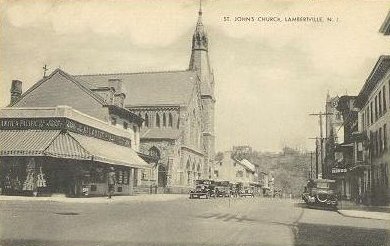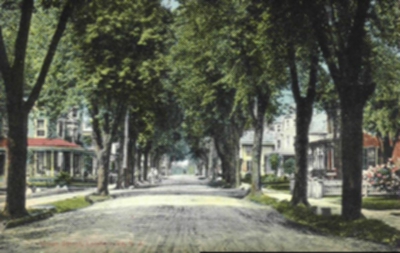Written In 1952
As you may know, I've been away from Lambertville for most of the last twenty-five years - and continuously for the past seventeen.
I generally managed to get back once a year, at least, and drink from the springs of my youth, Last March, I my mother moved from Lambertville to Passaic, which meant that the I town was empty of Cruises for the first time in nearly seventy-five years, I believe it was a sharper pang than the severance of the umbilical cord.
I stayed at my uncle's in New Hope, Dr. John Flood. He and Mrs. Flood have done a tremendous job in the restoration of their 200-year-old home. It's perfectly beautiful, but avoids the unhappy results of some restorations. You get a sensation of old and comfortable, rather than restored and brittle. Their home must elicit reminiscence and happy memory, for when I walked down to the river's edge at the front of their yard, I saw Lambertville as it was twenty-five and thirty years ago. Perhaps it's more accurate to say that I saw it as it's always been and always will be.
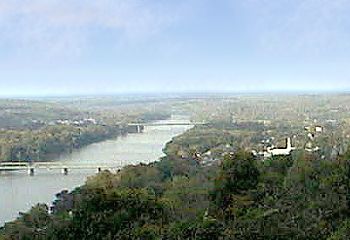
I looked across, and up and down, the river. I saw the river itself in its unending return to the sea. Up the river, I could see its bend below Stockton and knew it flowed past , many spots that were there-the quarries, the cemetery above town, the Aleauken creek, the trestle, the upper aqueduct, the island with its sand bar at the top (the Big Inch pipeline now crosses about there), its swimming places, "The Point" and the well remembered "Rock," Mrs. Mack's canoe place, "The Park" and the old feed mill. Though they weren't there, I could see Bill Lewis and the shad fishermen sweeping their nets all day long, with Bill Prestman "holding land." (I've heard that they once caught a sturgeon and sold it for a then fabulous $1 a pound.)
I can see the spot where the "Canoe Club" stood some time ago just below the bridge, and the bridge itself is there, where once Mr. Pew took our two pennies toll for walking to New Hope. It's free now, but any price I would be modest to get on the bridge at night. Often have I stood on the bridge at night and watched the lights and shadows on the river's face, and above, the world, the sky, all God's universe. It's a wondrous and awesome place, the bridge at night.
Below the bridge, the Dilly-Dally, a tantalizing name for the mouth of the Swan Creek. Here Nicky Russo drowned when we were kids. And still, as then, the creek runs into the river and the river on to the sea. Further down is Purdy's. Every place they caught shad made good swimming and Purdy's was no exception. And before the river's lower bend, the Falls. Some have "shot the falls" and lived and some have died.
I remember, in the days when a stranger in Lambertville was a rare thing, a man staying at the Lambertville House couldn't sleep. He complained of hearing a strange distant roar always. After much inquiry and many tests, we learned that it was The Falls that kept him up. To our accustomed ears, there was no roar, no noise at all, no more than birds at day or frogs by night were noise. Like many a beauty, we live, rather than see or know, we miss The Falls away. But it's good to know they're always there.
Beyond the river are the hills. Dark Hollow below New Hope, Baumann's straight athwart the river, the hill down at the County Farm, Goat Hill, Cemetery Hill, Cottage Hill, the School Hill, The Commons, the hill along the upper end of town that never had a name for me beyond "The Hill" where Teddy Sharpe knocked his homers, Erickson's, and that low, soft-rising field just below Stockton that's best seen from the bridge. This last hill, from some irrational cause, for me always brings to mind a line from Hausman, "On the idle hill of summer..."
On the hills you can really watch "the yearly pageant as it goes..." From gaunt winter to the burgeoning of Spring, on through summer's green to autumn's lavish glory, the hills will mark the season. After Fall has bathed the sides of the valley in light, any result other than winter's short surcease would be anticlimactic. The hills, like The Falls, are always there, and while they may have affected us insidiously, we didn't miss them till we left. Truly are they the Hills of Home.
I remember once going past the hill at the County Farm. It was early on a Spring morning. (I was probably going with my mother "on the pass" for an outing at Cadwalader Park.) The early green of Spring on the side of the hill was covered in a thousand scattered spots with patches of mountain pinks. I have never forgotten the leap of my heart that morning. Some years later, evidently about the time I was introduced to Mr. Chaucer, I remember writing:
No orchids can I bring for your corsage,
Nor charm your heart with dancing's.
but I can take your hand on pilgrimage
To drink from springs of pinks upon the hills.
The hills in winter had their uses, too. I'll never understand how such a simple thing as sled-riding could be so much fun. It wasn't just riding belly-bumper down the hill with the wind and snow in your face. There was fun, too, in walking up, throwing snowballs, rubbing someone's face in the show, or even getting it rubbed yourself. There was fun in standing around, watching the sleds come down, piled four and five high sometimes. There was fun in sitting on sleds at the top of the hill and talking. Sometimes there was a fire, and at night the dark added a quiet new joy. At night, in the frost, a shout could be heard from the top of the hill to the bottom, and all along between.
To talk of sledding is to talk of "The Hack." Many and wondrous were the tales of The Hack. It rode the hill before our time, but it was still alive on the tongues of men when we were growing up. It was made of two sleds built of the stoutest oak and connected by a plank as strong as iron. Its runners were wrought in the Lambertville Shops, and it had a specially cast bell to warn of its coming. When the bell of The Hack rang out at the top, the hill was cleared without inquiry.
Cottage Hill was the course or The Hack, and legion were the tales of its speed. Once, on a winter's night, a salesman came out of Jake Holcombe's store at the top of Cottage Hill. His last stop was Jake's and Mrs. Holcombe had asked him in for dinner. The salesman had made a mistake in time tables and found himself with only two minutes to make the 8:02.
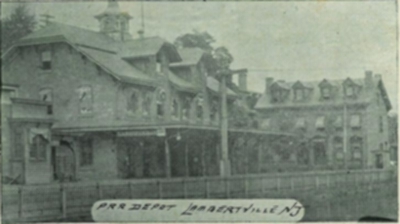
One of the Irishmen on The Hack, which was just getting ready to take off, overheard the salesman say he couldn't make the train and would have to stay the night in town. "We'll get you there with time to spare, if you've a mind to ride." The salesman had no hope to make the train but saw that he could save a walk down town, and so agreed. He got on about the middle. They rang the bell of The Hack, and sailed the length of the hill and half way up the canal bank at the lower aqueduct ("Ackridock" to us for many years). The salesman was limp as they lifted him across the frozen canal and over the rail to catch his train. Thereafter, he called at Jake's by day.
You can conceive the speed of The Hack from a tale that's told of Tommy Mack (the elder). When asked how fast The Hack could ride Tommy averred it took him three trips to say a decate of the Rosary. When pressed as to how he marked the time so fine, he answered, "There's many a thing a man might forget when riding The Hack, but saying his prayers ain't one.
They sled no more on the snowy hills. Each hill used to have its special pleasure - the bumps of Cemetery, the speed of Cottage, the rutted ice of the front Hook, the speed and turn on the Schoolie, an extra bump on The Commons before you entered that alley of unmentionable name, and the long sure ride of the York Road. All are gone now before The Highway, the automobiles and snow ploughs. We were wise to enjoy it so much.
Between the river and the hills lies the town, still. And now, with the sun on the side of the town, I see the buildings and what they mean to me. The steeples stand out and mark the churches below. I see St. John's where I was baptized, made my First Communion, and where I was confirmed with Paul Malloy at my right shoulder. There is the Baptist Church where we heard our Baccalaureate and the Presbyterian Church where Gill Robb Wilson spoke at our Commencement. From that June, 1927, speech I remember one passage. Gill Robb at one point said, "Some of you will go on to college. From time to time you will wonder whether you are spending too much time preparing for life rather than living. At such times you should remember one who spent thirty years preparing for a public life of three."
Perhaps the town seems changed, but only superficially. The principal streets are asphalt now, and parking meters are dreary substitutes for the trees that shaded Bridge Street. But Union Street above Jefferson holds the ageless flavor we always knew. The streets we ran, the curbs we walked, the grapes we stole, the maple seeds we whistled - they are there, and still enjoyed, no doubt.
There are new things in town. Atop the hill on the left as you go out the York Road is the Lambertville Music Circus. This is new and wonderful beyond compare. They play operetta and musical comedy. You have never known Victor Herbert until you've heard Robert Feyti sing "Every Day Is Ladies Day With Me." The Music Circus tent (which seats a thousand plus at an average of $3.50 every night) sets in what was probably Lambertville's first and only subdivision. You may remember Mr. Woodward sold homesites there some years ago. Half a dozen homes were actually built there. Now each of those home owners has set up a hot dog stand in his front yard to serve the Music Circus patrons. Thus, St. John Terrell has the world beating a pathway into the same forest that grew up in weeds over Mr. Woodward's idea.
There are many new faces in the streets of town, but many old ones, too. To see another generation mirrored in the faces of today's children is an intimation of immortality in itself. But you can see it in Lambertville.
Stand any night on the Bank corner and you say to yourself as boys and girls go by - "There's an Ennis, he's a Colligan, she's a Leary, there's a Stout." (Stout's a name to conjure with, in Lambertville, at least). I well remember the Stouts who lived below us on Ferry Street. They had five boys with such ordinary given names as Raymond, and Elmer and William. But in Lambertville these boys were universally known as Pay, Mitty, Dopey, Stinky and Bulligan! Where, but in Lambertville, could such engaging nicknames cluster under a single roof'? As the young go by you may feel old, but you needn't. The world is old and young at once. As we grow old we can relive and sharpen the joys of our youth, the while we happily live in the present.
The days of our schooling truly were good, but these are good days, too. With the dogs war unleashed and the cry of Havoc harsh upon the land for nearly a decade and a half, we live uneasily now. Our life is less bucolic than in 1927. But what is good survives. As with Lambertville, so with us. While the river flows and the falls roar, the hills look down and guard what we loved in Lambertville.
This started to be a brief narrative description of how the town is now. It turned out to be a long and most discursive epistle of how things were a quarter of a century ago, and now.
Chris Knoster was toastmaster and M.C. of the affair. As you will expect, we sang "Against Our High School Spirit" and there were undoubtedly a good many memories crowded into the two verses of that ancient song. A number of the committee members read letters from people who were unable to attend.
We had a turkey dinner and gave out the 5 and 10 cent store prizes for "the fattest man," "the baldest man," "the shapeliest girl," etc. (Cruise was a three time winner: (a) longest distance traveled, (b) youngest child, our year-old twins, and (c) most children, five!) Everybody had a lot of fun out of it. Hub Heisel very graciously and effectively expressed the group's thanks to the half dozen hard working committee members who had made the thing possible. We then broke up into an informal party and exchanged experiences, pleasantries and small talk while a trio worked in a corner on a saxophone, bass fiddle and accordion.
Altogether the party had the fine, wholesome flavor of a strawberry social. We broke up between 11 and 12 o'clock and everyone agreed that it had been a famous evening.
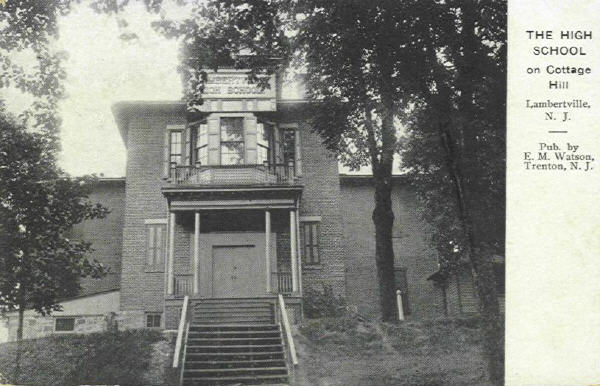
CRUISE | FLOOD | WRITINGS | HOME
Related Links
Lambertville Historical Society
Lambertville Chamber of Commerce
